It’s true (and yes…I’ve had Willie Nelson in my head ever since snapping this pic!) we’ve had nothing but blue skies all week - the most glorious days beginning crisp; with a heavy dew underfoot and a sun that shines warm and bright, encouraging all those newly sown seeds to rise up and forge their way through the good earth. ‘Tis a golden time of year…
One I love…as late summer merges, seeping slowly into the autumn-proper that’s yet to arrive - such is our climate. It’s only in the last couple of days that the merest hint of leaf-colour has become evident - a tint here and there on the Persimmon trees indicating the colourful vision to come.
For the last two months, early autumn has been clearly represented by the brightest of pink flowers atop the Silk Floss Tree, Ceiba speciosa, creating a crowning glory visible from almost everywhere in the garden. Formerly known as Chorisia speciosa, when I ordered it about 30 years ago and it arrived by mail order as a tiny, dormant stick about 5 inches high and already displaying prominent ‘thorns’ that would eventually cover its exquisite trunk, it was named simply Kapok Tree (which really, it is not!).
When it was much smaller, I could easily reach a bounty of those beautiful bright pink flowers with their orchid-like markings and at this time of year, they would make a lovely display, each popped individually into a glass jar on a long table…or just one on the windowsill. But these days I can’t reach even one! The huge pods seem to develop at a rate of knots from those flowers on high; and there they will hang, all winter long, gradually ripening and wizening, til eventually, one dry and windy spring day, they’ll burst open and cast their downy fibre all around. Then, the entire garden to the front of the house will look as though a huge pillow fight has played out!
So enchanting do I find the trunk of this tree, that I persuaded my lovely publisher (it didn’t take much to persuade Diana!) that an image capturing its exquisite form would make for handsome endpapers to The House and Garden at Glenmore.
A drought tolerant specimen (the reason I ordered it in the first place) it grows in one of the toughest parts of the garden, where it receives no attention; and save the first year when it was tiny, no water at all. By now its roots are twisted, knotty and sprawling and it dominates the Persimmon Lawn. I estimate all the pink flowers will drop in the next week…so they’ll not be clashing with the riotous persimmon colours that are about to unfold!
Many parts of the ornamental garden really aren’t worth remarking on just now - heading into dormancy, they’re at a dull stage - having had their star turn in spring and/or summer. It’s too early to prune, so they languish. It’s just the way it is. I don’t mind because although there may be dips and gaps and plain bits, there’s still always something to captivate and draw the eye. I’m inclined to be drawn to small details, so mind not the collapse all around when there’s even one beauty such as this single mottled specimen of hydrangea. Why it came to flower later than its neighbours I’ve no idea. The colouring of the others has long since deepened (at least the petals that weren’t baked on those days of intense heat…those are a bit ugly but again…’tis what nature has brought: the colourful ones are magic and I never cut them back ‘til late winter, which I think protects the young buds forming for the following season).
I’m quite content to focus on the handful of glorious autumn rose blooms, the last hurrah of dahlias that make for lovely arrangements and still…the afternoon light on the swathes of Perovskia in the Barn Garden and plumes of Miscanthus sinensis in the Borders are breathtaking.
The annual ritual of sowing the garlic became an Anzac Day thing for me many years ago. I can’t recall quite how it began…it was probably more of an ‘oh no I haven’t had time and it’s almost too late…and it’s a nominal holiday - let’s take the opportunity’ kind of reason, than a conscious one. For years I’ve been suggesting to peeps that if they haven’t sown their garlic by Anzac Day, then to use it as a marker, and to do so as soon as possible. Part of me always means to sow earlier and yet…I never do. I suspect it’s because it’s become a self-imposed tradition that I enjoy.
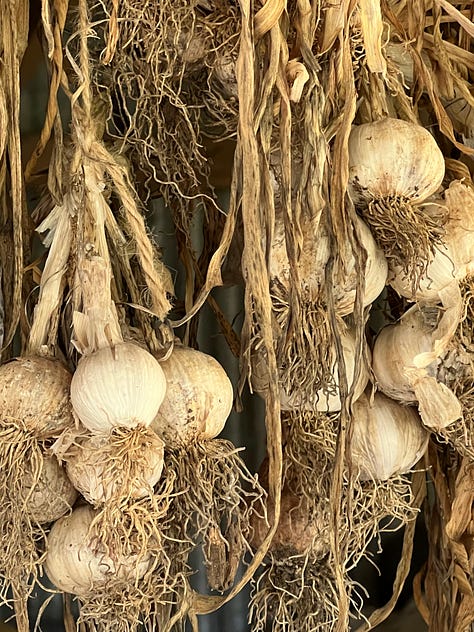
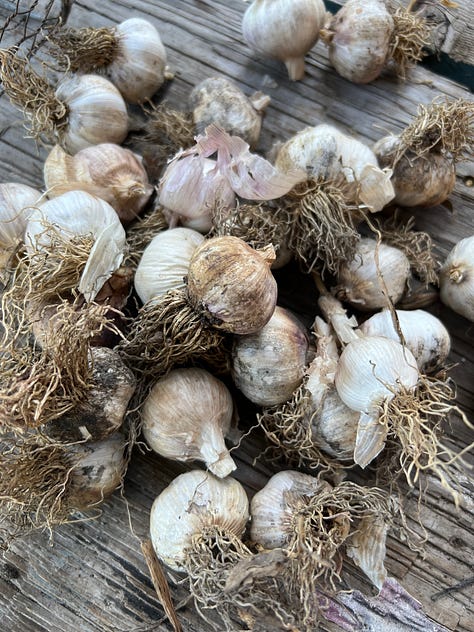
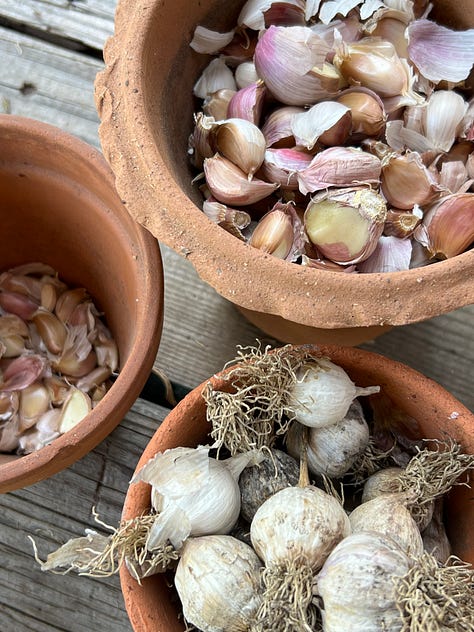
First…I cut down the heads that have been hanging by their dried out stems in the potting shed since they were pulled late last spring. These will be the largest heads from the last crop. Although annoying, I force myself to use the tiddly ones in the kitchen first! Of course the temptation (with my cook’s hat on) is to use the largest and least fiddly for cooking; but with my gardener’s hat firmly winning out (I’m always looking to improve my stock) instead save the best…the largest cloves from the largest heads of garlic to sow! Then greedy me takes over during the sorting process as I also want a harvest big enough if possible, to give us a year’s worth of garlic to eat! So surely including some small cloves from the largest heads won’t hurt?
The sorting process involves breaking the heads apart, separating the cloves, grading in effect…sending the tiniest to the kitchen and gathering the favoured ones for the next phase. All the roots and fine papery skins, along with the dried old leaves go to the compost where they make a good ‘dry’ layer.
Then…it’s off to the garden to sow. I always position my garlic somewhere ‘down the back’. As I aim for a minimum of 200 cloves (I counted just over this time…taking into account some of those smaller ones!) they take up a reasonable amount of space and for a long period of time - they’ll be occupying their spot for a good six months which needs to be taken into the crop-rotation account. Garlic…is a longterm prospect.
When I refer to ‘down the back’, it accounts for numerous areas I reclaimed a long while ago, in a stealthy kind of manner (ie when Larry wasn’t looking!). I needed an ‘overflow’ area from the kitchen garden proper, to grow some crops on a bigger scale. Employing the ‘no dig’ principles we have done from the very start, I began marking out beds around the ‘drying green’ (where the washing line is) with layers of newspaper and cardboard when Larry was otherwise distracted (spinning around the world at a rate of knots as he was once inclined more often, to do!). For a long time now, these spillover beds have produced some of our best eating and I believe grow some of our best produce because…they are in the ground, as opposed to being in raised beds (a point I’ll come back to another time). I still practice crop rotation here and the area I’ve chosen to sow the garlic is one that’s had an active summer and previous autumn, pumping out various crops…but none of them root veg. I think it could do with a little garlic cleanse!
I like the idea of ritual, and this has become my way of marking Anzac Day. Already in the small number of posts so far, you’ve probably come to gather I spend quite an amount of time engaged in tasks that require busy hands, with a head either focussed intently on the task at hand or…at one where the mind is free to wander, to ponder…and the garlic process on Anzac Day is one of the latter. The opportunity to reflect on the meaning of this particular day is always inclined to bring a rush of thoughts and memories flooding in.
As I went about the garlic task yesterday, I couldn’t help but think on how my generation is likely the last to have known generations first-hand, for whom the First and Second World Wars had such enormous impact. (I realise the term Anzac refers to all theatres of war in which our brave people of Service have participated, including more recent conflicts) and yet, it’s to those two aforementioned that my mind is inclined to fly when I hear the term Anzac. Perhaps it’s only now, in retrospect, that I realise how as a child, I was always acutely aware that the war had played a major part in relatively recent times and especially in the lives of my grandparents’ generation. In reality, that carried-over atmosphere underpinned my childhood (as no doubt it did for all my generation). Although WWII had ended some two decades earlier, its legacy was unavoidable.
As a small child, I spent a great deal of time with my maternal grandparents (my Mum worked, which at the time was not the case for many of her generation). I was just shy of 7 years old when my brother was born, so my early childhood was pretty much as an ‘only’, just as my Mum had been; and as I guess my grandparents had done with my mother, were inclined to take me along to whatever they were doing or wherever they were going - be that fishing, to work (definitely responsible for my love of hats!) to see friends…or even to the races! (Truly…I was well experienced at choosing a winner by age 4, by closing my eyes and stabbing a pencil at the list of horse’s names in the programme!) dressed in my best little fine blue wool dress with puffed sleeves and embroidery, matching coat and blue buckle shoes, sitting in a very well-behaved manner with my well-turned out grandmother in the Member’s Stand at Randwick Racecourse! I’m sure it wouldn’t be allowed today and have no idea how they got away with taking me back then, but you’d need to pay me a small fortune to go anywhere near a racecourse today!
Some regular outings though, were to see their friends. That era was still governed by the idiom that ‘children be seen and not heard’ and although neither my parents or grandparents were strict disciplinarians, it was just a given - I would sit quietly, as expected, and therefore, listen. Their conversations were still permeated by tales of war. One particular of their friends lived close by - Aunty Vi…and we three would walk to see her, in her very contemporary, newly-built apartment between Double Bay and Point Piper, with views over the sparkling waters that shimmered so bright below, everyone needed to wear sunglasses inside (whilst their reflections made for captivating shadow play on the underside of the balcony above Vi’s apartment). Vi’s husband had returned emaciated from being a prisoner of war at Changi and never fully recovered. I don’t believe I ever actually saw or met him…was he bedridden? Conversations were always in hushed tones when we went to visit…there was a great sadness to that generation, although it seemed to me to be equalled with enormous joviality - they truly knew how to have fun too. Vi was always dressed in vivid swirly prints, with bright pink lipstick and short lacquered, blonde hair. She smoked du Maurier cigarettes (as did my grandmother - though she had just one after lunch and one after dinner) which came in a very distinctive orange/red box, highlighted with a band of fine gold lines. Vi had ‘owned property’ at Surfers Paradise…before it became the Gold Coast of today…and I know my Mum had spent vast tracts of her childhood up there. I wonder what happened to Vi? Similarly, Peggy lived next door to my grandparents. They lived in apartment blocks side by side and there was a sad story to Peg as well, though in this case I think it was her brother. I never saw him either. We’d wave to Peg and her budgerigar at breakfast whenever I stayed overnight - it was my grandparents’ way of watching out for her and I know had she not waved back on any given day they’d have been over there like a shot to check she was OK.
My maternal grandfather hadn’t gone to war - deaf in one ear since a very bad car accident as a young man, he didn’t pass the physical. Instead, he was an ARP Warden for Double Bay and I cannot imagine the real shock for the residents of Sydney, when on 31 May 1942, three midget Japanese submarines made their way into the harbour. My grandfather packed my Mum and grandmother ‘off to the country’ where they spent many months in the Southern Highlands. It doesn’t sound so bad, but I’ve no doubt all those years were anxious for one and all.
I spent little time with my paternal grandparents who lived on Sydney’s North Shore - which meant an irregular trek to see them. Funnily enough, as things turn out, I have a feeling I have so much more in common with my paternal grandmother (she was a gardener and the one who introduced me to the ‘no dig principle’ when we came to Glenmore) although as a child I was terrified of her! Grandad spent the war years in the Australian Navy and being away for most of it, my Grandmother took her two boys for those years to stay with relations at Cassilis in the Upper Hunter Valley. Grandad died when I was 10 and I’ve always had a feeling that behind those twinkling green eyes, had I been older and bold enough to ask, there would’ve been plenty of tales to hear. But in that house too, remnants of the war years permeated…it’s the way it was. Grandad always joined in the march on Anzac Day and post war, my Dad was in the Naval Reserve as a young man but saw no active service.
When I met Larry’s Pa many years later, tales of his colourful role in the Royal Navy were rapidly forthcoming and enough to make my hair stand on end! One Easter (the year Larry and I were engaged but not yet married) we took Captain R to revisit Crete, where during the war he’d been wounded whilst assisting with the evacuation of Allied troops, including Anzacs. I think he rather liked that I was an Aussie, and meeting him the same year Australia won the America’s Cup, I was instantly nicknamed and proudly introduced to everyone in his circle in Pollenca, Mallorca (to where he and Larry’s Ma had retreated from Scotland in order to live somewhere warm to be kind to Captain R’s many war-wounds) as Miss Australia II! (For those too young to recall, Australia II was the name of the yacht that secured the Cup!).
All those old thoughts can be packed away now. By the time my piecrust pot was empty, my string-line put away, the bed watered and mulched, I’d thought through the generations…the relations returned, the ones who had not, the still-confronting visions on the pavements, even in the 60’s of the returned brave with missing limbs; and the weight still carried by so many.
Lest we forget…
As the garlic was not an all-day job, I took the opportunity to catch up on a few other tasks that had been evading me thus far. I tied all the crossbars to the broad bean frame and….remember how I said it was nail-biting time for the seed I’d sown the previous week? Well…look!!! They’re up! All but one! Seems to me there’s always one absentee! Did I forget to sow it? I mean 19 out of 20 does seem a bit odd. I’ll give it another couple of days and if it’s still a no-show…then I’ll pop another in its place!
In a similar vein, the peas I sowed the week before are up…in four frames out of five! Did I forget to sow those? Surely not…but it does beg the question!!!! Now you may think this approach is odd (I’ve explained the copper ring which I won’t remove quite yet in this instance…I’d like the peas to be a bit more advanced - they’re still very susceptible to attack by wood slater and slugs at this stage) and you’re right. I would be much happier to sow one pea seed at the base of each upright rod of my wigwam. It’s what I used to do. Before the arrival of the Bowerbirds. Once I realised the problem, I had to find a way to solve it. I’m still trying…but this is the best method I seem to be able to muster. It would be better (obviously) if each pea root had its own space to roam…all I can hope is that their roots sort it out amongst themselves! It’s worked the last years. You can see I’ve quickly popped in an inner circle of pea sticks to fend off likely Bowerbird attack - although not impenetrable, hopefully it’s at least a slight deterrant. At the weekend I’ll make another round but I also don’t want to prevent sunlight from penetrating to those newly sprouted seedlings.
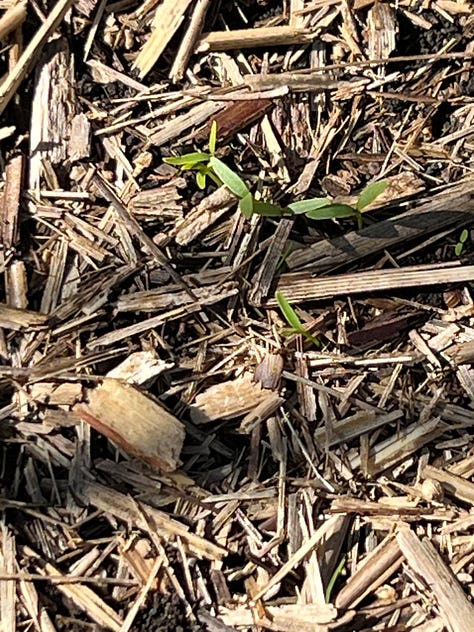
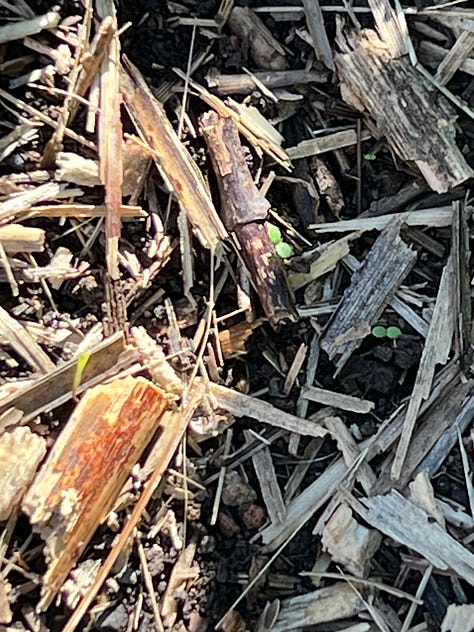

There’s newly germinated coriander and dill (no sign of the chervil yet) and the second sowing of beetroot is just very gingerly, pushing up through the soil. It’s all tantalisingly exciting - to the eye and very soon, will be for the tastebuds too!
Directly where we built the series of three new pea wigwams last week, I purposely left in an old row of summer-grown beetroot. They hadn’t come to much in the ‘bulbous’ department (as I’d thought - they were a second, very late sowing that caught the westerly summer sun all afternoon long). So…I stripped off their ugly big leaves, gave them some compost, added mulch and…now back to their basics, they’re sending out a crop of delicate new leaves, perfect to add to leaf salads or the slightly tougher ones, to wilt down and add as a final flourish to whatever’s on our plate.
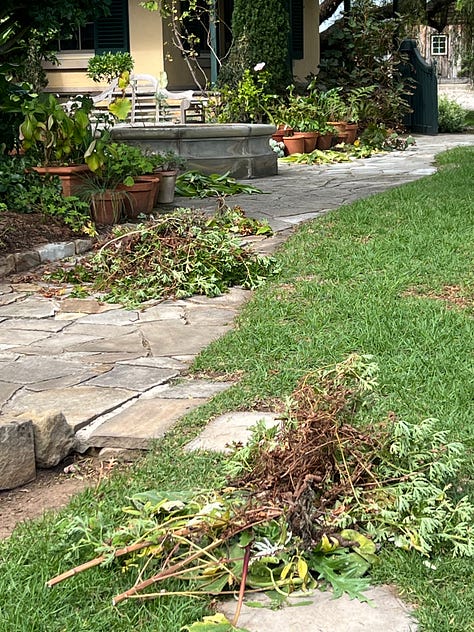
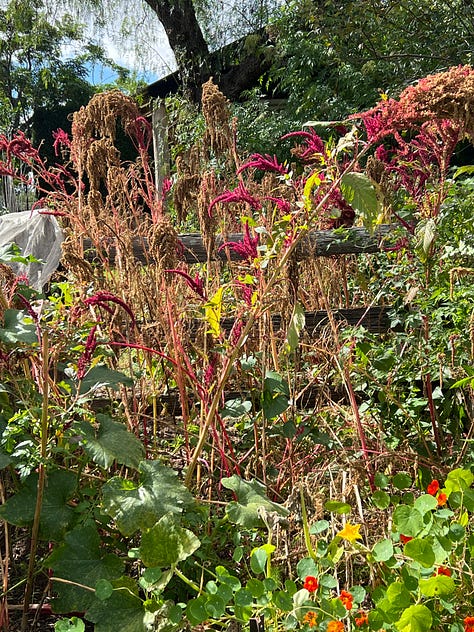
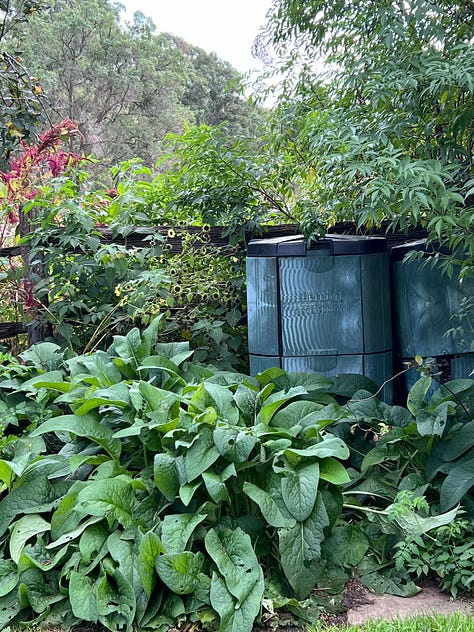
Remember how excited I was at the prospect of a whole weekend in which to garden? Gardening comes in all kinds of forms - from the fiddly, nit-picking kind (satisfying in their own way - I’m always just longing to get those kinds done) to really big jobs! And I was very happy to have some of those to get stuck into. I tackled the Courtyard pots (before intending to - I hadn’t got the wheelbarrow in position so had a whole lot of little piles to pick up later!) and then…woohoo…took to what had been a vision down the back but in recent weeks had become a great big mess. I pulled out stem after thick stem of tall Amaranth, cut the very messy Cape Gooseberry shrubs back to a few good branches (I may miss some fruit but ugly growth doesn’t ever improve!) and unearthed some hitherto unseen rampant tomatoes in the process. I’ve cleared around the sweet potato and may go a-digging to see what I can find there this weekend.
Then…I took to the Comfrey leaves around the pair of aerobins (where all our food scraps go). The bins themselves are a bit of an eyesore but they do a good job and the Comfrey makes a good job of disguising them through the warmer months. Comfrey, is a good compost activator, and I pop a leaf or two into the aerobin with each addition from the house bucket. Then, when it comes to turning the big compost…I collect as many of the big leaves on their stretchy stems as I can, to layer in as we go. So on Sunday, I stripped these plants of all but their very new inner leaves (at this stage of the season there’s a good chance I’ll get another flush) in readiness for…the big compost turn!
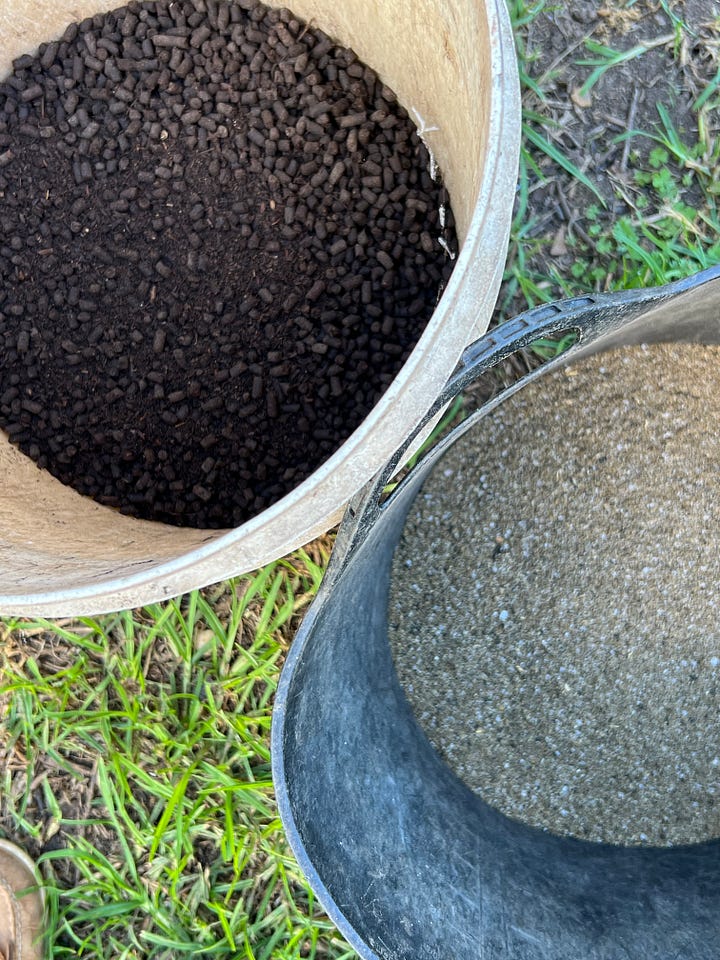
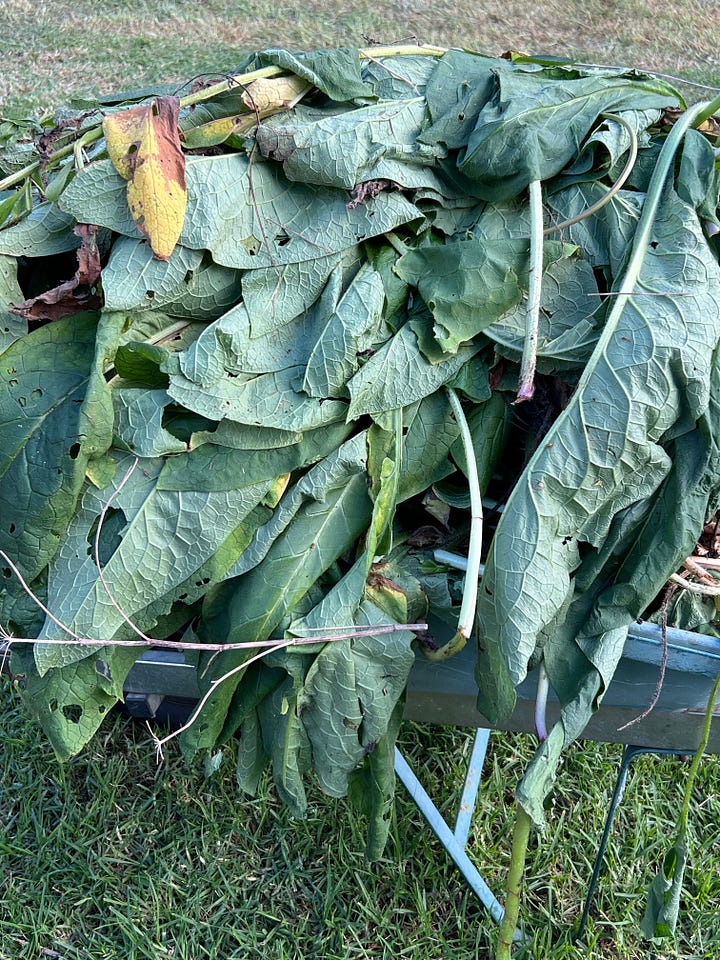
Next, I gathered together the inputs I’d be using this time around (it’s a second turn) and in this case, it was a good load of chicken manure pellets, blood and bone and my wheelbarrow load of comfrey leaves along with the hose, for water. I wasn’t too thorough with my image taking this time around (I seem to have done it so many times before!) and do still encourage you to listen to and take a look at the notes for the Podcast episode two, where I explain compost there in detail too.
But in essence, it’s always pretty much the same. Begin with good watering of worm liquid if you have it (which I didn’t this time…I need to begin the worm farm again but we have no shortage of earthworms!) or just water the ground well - be sure you are making compost on the bare ground / earth…the worms will come of their own accord. Add green material. Water. Toss over a handful of chook manure pellets. Water. Add a dry layer (dried botanicals, twiggy material, cardboard). Water. Scatter blood & bone. Water. Add green material. And so it goes, layer after layer…’til you’ve incorporated all the material you have.
Our compost heap is huge. To put it mildly! We’re adding volumes of material to it all the time. So by the time we get to turning it (for which we use the tractor for heavy lifting) some material has already partially broken down. I don’t pay quite so much attention (which I would if it was a smaller heap) to the green / brown ratio. I’m sure though to layer in the water, chook pellets, blood & bone and comfrey, between each layer. And grass clippings if we have them on hand. They really make things zip along.
If we allowed it all to sit there for a year without turning, it would probably all break down of its own accord…but there would still be clumps of something stuck together. Turning oxygenates it. Aerates it. This turn was a case in point. Having turned it once previously, its height in the bay when we began last Sunday was about a quarter of the bay’s height from the top (meaning it has already broken down considerably since the first turn). Post turn, now all fluffed up but with no extra volume of material added (the handfuls of pellets and blood & bone and comfrey pretty much account to zero) its height was now well above that of the bay. I had to ask Larry to rest the tractor bucket on top gently, to flatten it out a bit so I could get the hessian over the top! I can only suggest that extra volume accounts for air, which is a good thing.
At the end of the turning, I make several deep holes with a long star picket and…if I have some cowpat tea on hand or a biodynamic brew with which to inoculate the heap (we’ll come back to that, just as I’ll come back to more about compost!) I pour it into the holes. If I don’t, as I didn’t the other day, I fill the holes with water. Ensuring the heap has a good moisture content is important. Dry compost will be hydrophobic (ie it will repel, rather than absorb water) and as we are most likely going into a (traditionally) dry period now, it’s important to keep the moisture level in the compost up.
I then cover the compost as quickly as I possibly can - I don’t want to lose any precious microbial activity! I tend to use hessian - it begins life here on the tables at events. When it can do no more tables in pristine condition, I use it for various reasons in the garden, then to cover the compost. Eventually it breaks down and ends up in the compost itself. The best kind of material of all…natural and recyclable.
With all this activity going on ‘down the back’ it was a good opportunity to have a bonfire. We generally have two a year, burning material too big for the compost, and this was the first. The fine mist of smoke added a soft autumnal atmosphere to our big gardening weekend.
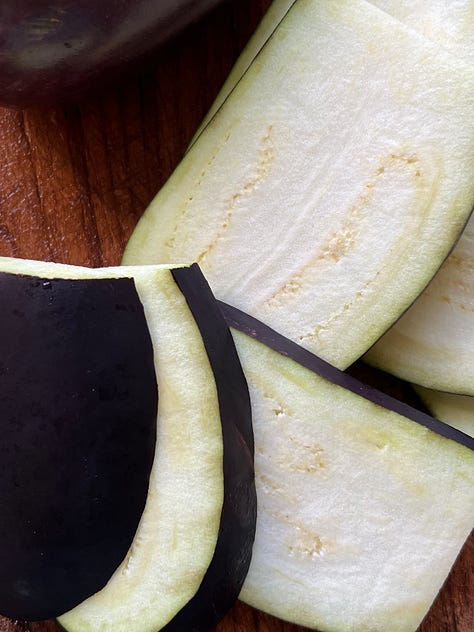
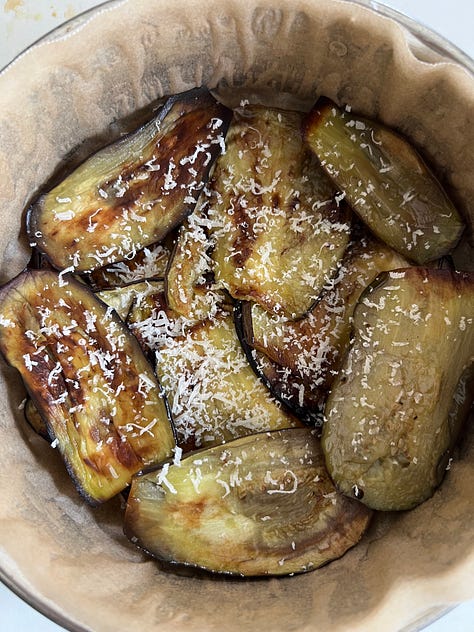
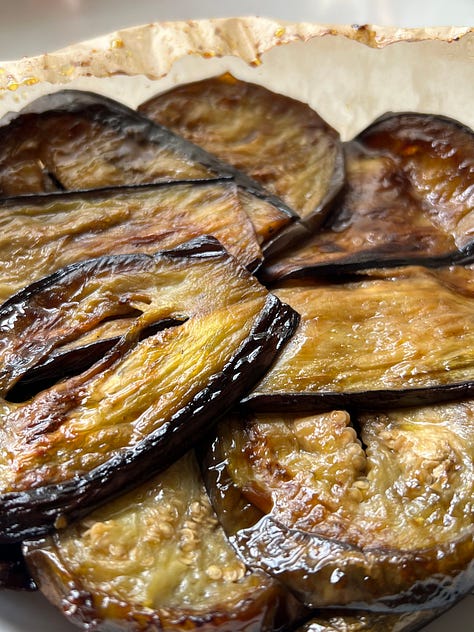
All the recent aubergines have been beautiful…unblemished and plump if not quite as plentiful as I’d like (I’m a glutton for eggplant!). But as it was only the two of us to share this modest bounty, it mattered not that it wasn’t the thing of beauty I make from time to time for a small event!
Mickey’s Torta di Melanzane
Ingredients
as many aubergines as you have (in this instance above, I had three small ones. When I’m baking this to create a wow factor, I use perhaps 9 large
Parmigiana Reggiano or Grana Padano to grate
Sea salt
Method
line (with minimal grease - I dot a couple of smears of butter just to hold the paper in position) a springform cake tin with baking paper - base and sides (choose the size of tin according to the number of aubergines you have on hand and go for a smaller tin than you think, so you get a taller result - trust me!)
slice and fry in (minimal as you can) olive oil, in batches. As each batch is cooked to golden on each side, I stack them on top of each other. I salt one side lightly in the cooking process - don’t go overboard. If you use too much oil, you’ll find it oozing everywhere, and the slices continue to warm and cook each other through in the stack. It’s also too easy to oversalt…so be light-handed
when the slices are all cooked, preheat the oven to about 190C and assemble in the cake tin. As you’ll be turning the torta out onto a plate, make sure the first (bottom) layer is arranged in an attractive way!
grate a little cheese between each layer…just enough to ‘glue’ the slices together (I like to taste pure aubergine - I love its taste, so I go easy on the cheese)
place the cake tin onto a baking tray in case it oozes oil - you don’t want that mess in the oven to clean up!
bake for 1/2 - 3/4 hour (you’ll gather by now that I tend to make things up as I go!)
I tend to take the torta from the oven at least 15 minutes before serving…it doesn’t need to be piping hot and is best left to sit and set awhile longer
When you’re ready, turn it out onto a plate. Release the sides of the tin and peel away the paper. The bottom, now top, should be quite a picture and thanks to cooking it in the tin, the sides should look multi-layered and it should hold its shape
Ours last weekend was a modest affair! I topped each plate with a dollop of fennel frond pistou and some gently panfried baby tomatoes. It was de-lish! But add as many layers as you can to the top of the tin and you’ll end up with a spectacular affair! I can’t tell you that won’t take hours of frying…it seemingly does, only for the whole to be devoured in an instant. Is it worth it? Every second! I might muster one more this season…and then it will be all over for another year. Too sad to contemplate…
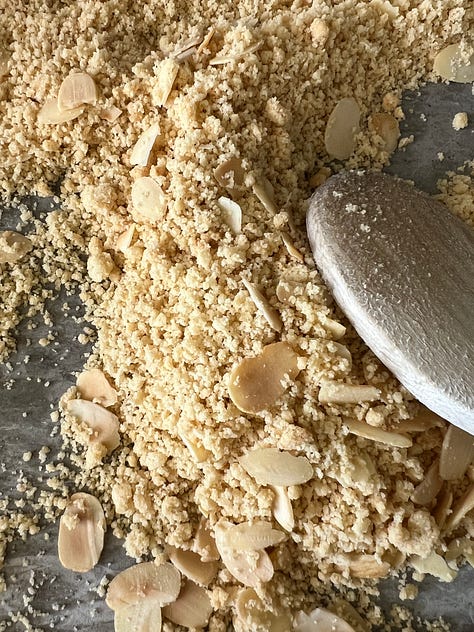
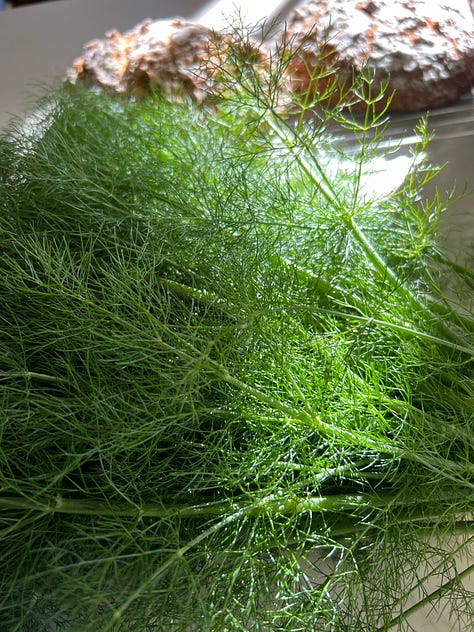
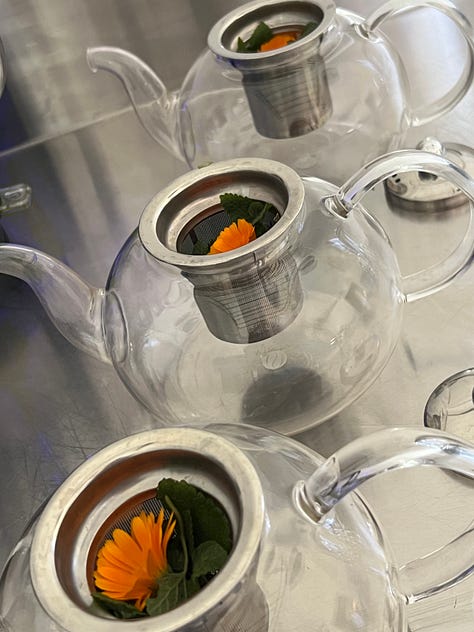
There was a lovely garden visit earlier this week…that had me cookin’ and pickin’ and preppin’ and hostin’; then washin’, and hangin’ and ironin’…as I do! The delightful group consisted of visitors from all over the country on their last stop but one…we’re often a convenient stop for garden tourers as they begin or end their journey with us and are likely to also view the Australian PlantBank at the Mount Annan Botanic Garden that’s enroute to or from here to their tour company’s pick-up/drop-off in Sydney.

And with that…I’ll leave you for another week. Tomorrow I have a small group of participants coming to join me for a spontaneous (I am inclined to hatch these things on the spur of the moment - the garden has so much to teach would-be kitchen-garden-growers right now that I couldn’t resist putting the idea out there!) Autumn Morning in the Kitchen Garden. I’ve baked a small Pumpernickel Soda Bread for them but really must go and do a little prep in the Dairy for their arrival…and write myself some lists for the morning!
I wish you all a wonderful weekend. Mickey x
Eating from the garden:
Fig, pomegranate, persimmon, rhubarb, tomato, aubergine, zucchini, leaves of all kinds - spinach, lettuce, radicchio, (I picked the first kale leaf just for fun - we haven’t yet had a frost and I want then to bulk up more before I really begin to pick!). Fennel fronds; parsley, mint, rosemary and thyme really go without saying…chives too. No new ripe Meyer lemons this week but all of a sudden, many of the citrus are showing a slight turning in colour. Of course we’re also still eating onions from the last harvest and garlic too…I now have a little terracotta pot sitting on the kitchen bench that’s filled to the brim with the last garlic heads that didn’t go into the ground!
Seed saving: Beans…Speckled Cranberry, Purple King, Rattlesnake; and fennel.
Sowing: Peas, broad beans, coriander, chervil, dill (I forgot to add beetroot to the seed list last week) and I’m mentioning these again here because I intend to sow more of each. Also rocket, cima di rapa and mustard greens - red elk and giant mustard.
Planting: my list of seedlings for this weekend (because I got the market day wrong last week so I hope to set off super early tomorrow before my workshop to get: more leeks, kale, broccoli, cauliflower, fennel, radicchio, lettuce (read successional sowing of all these) and…onions! Oooh and if they have them, two more globe artichokes to replace two thad didn’t make it through last season. Camden Market tomorrow morning for Patio Plants’ stall






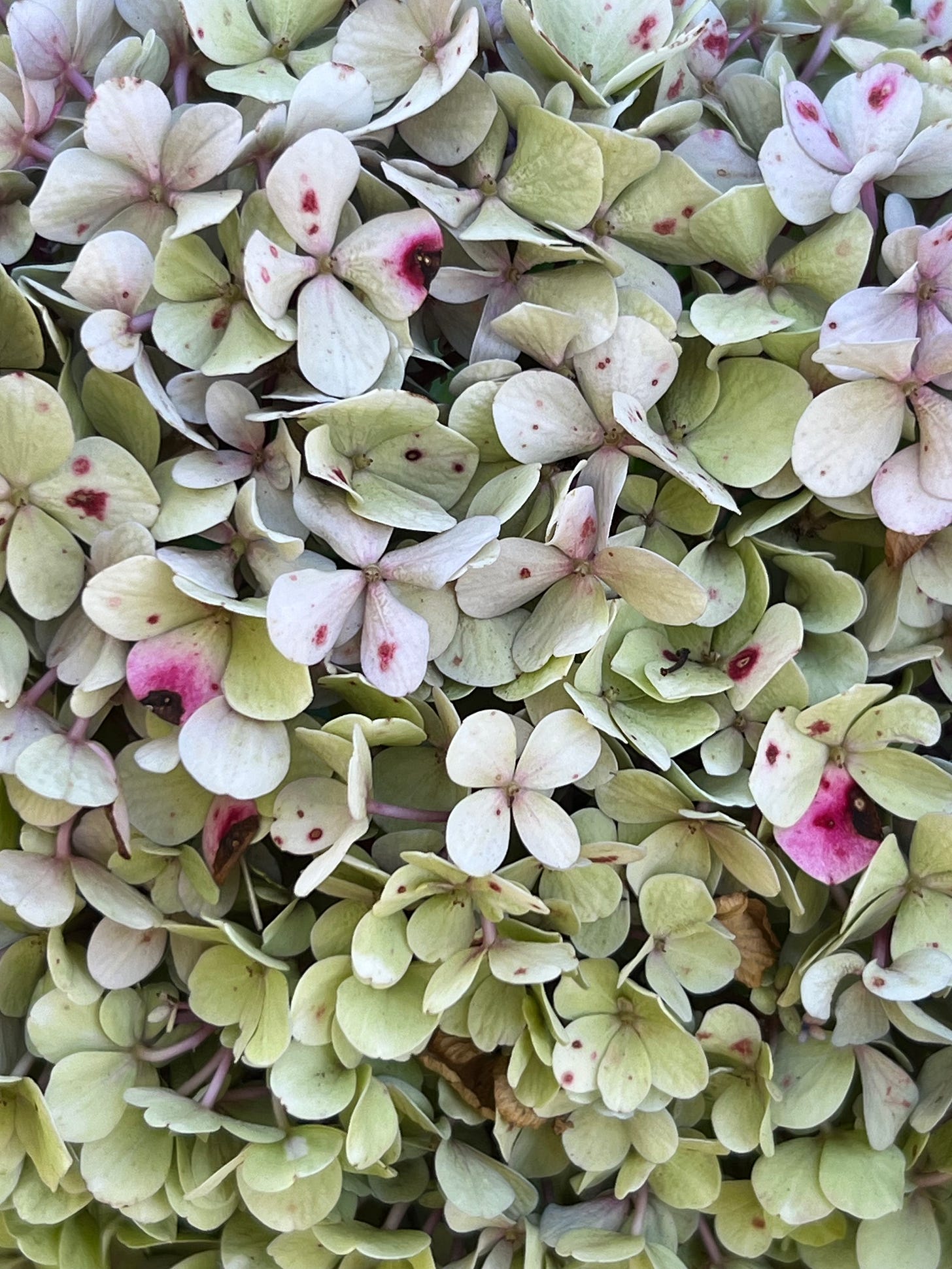
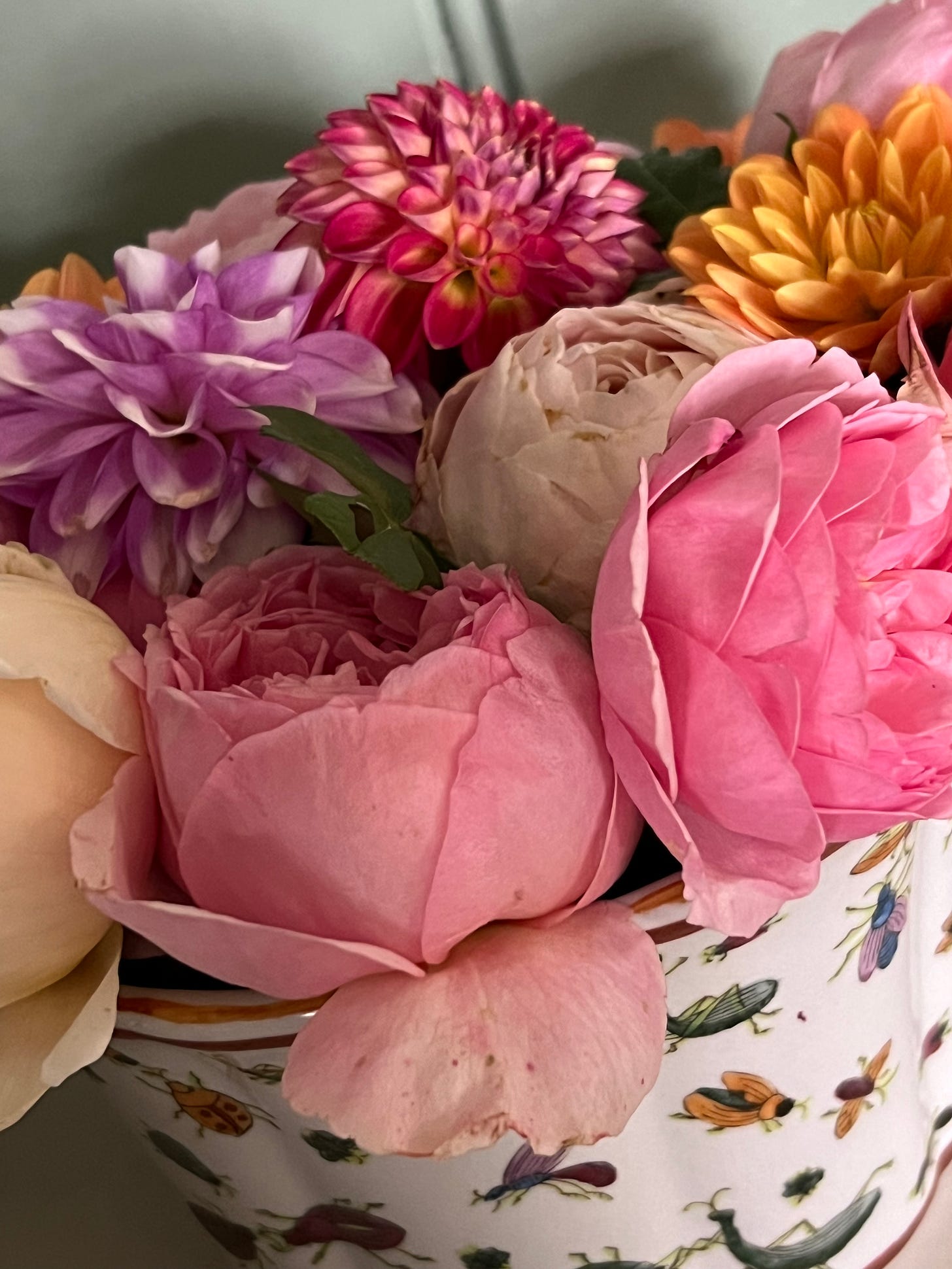


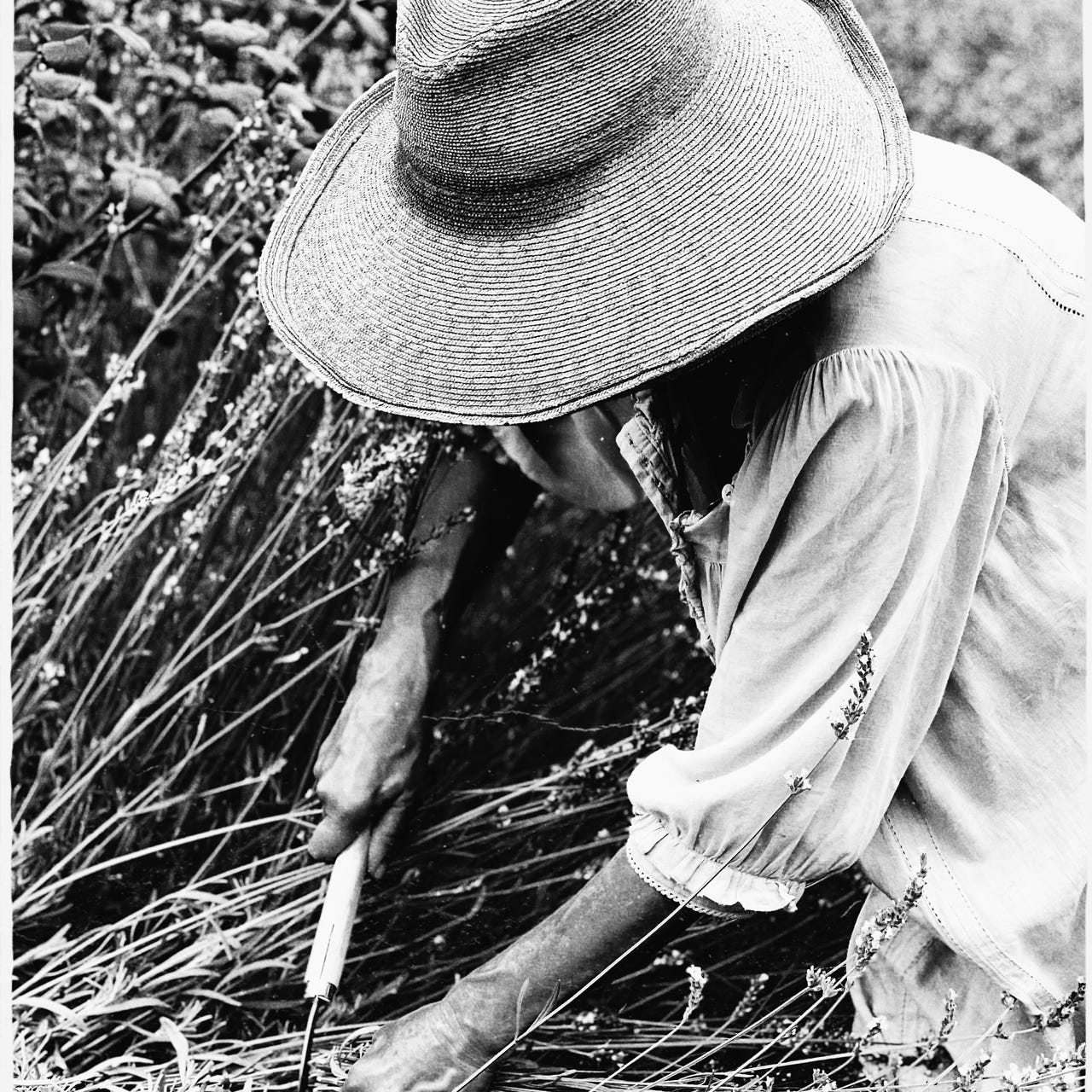




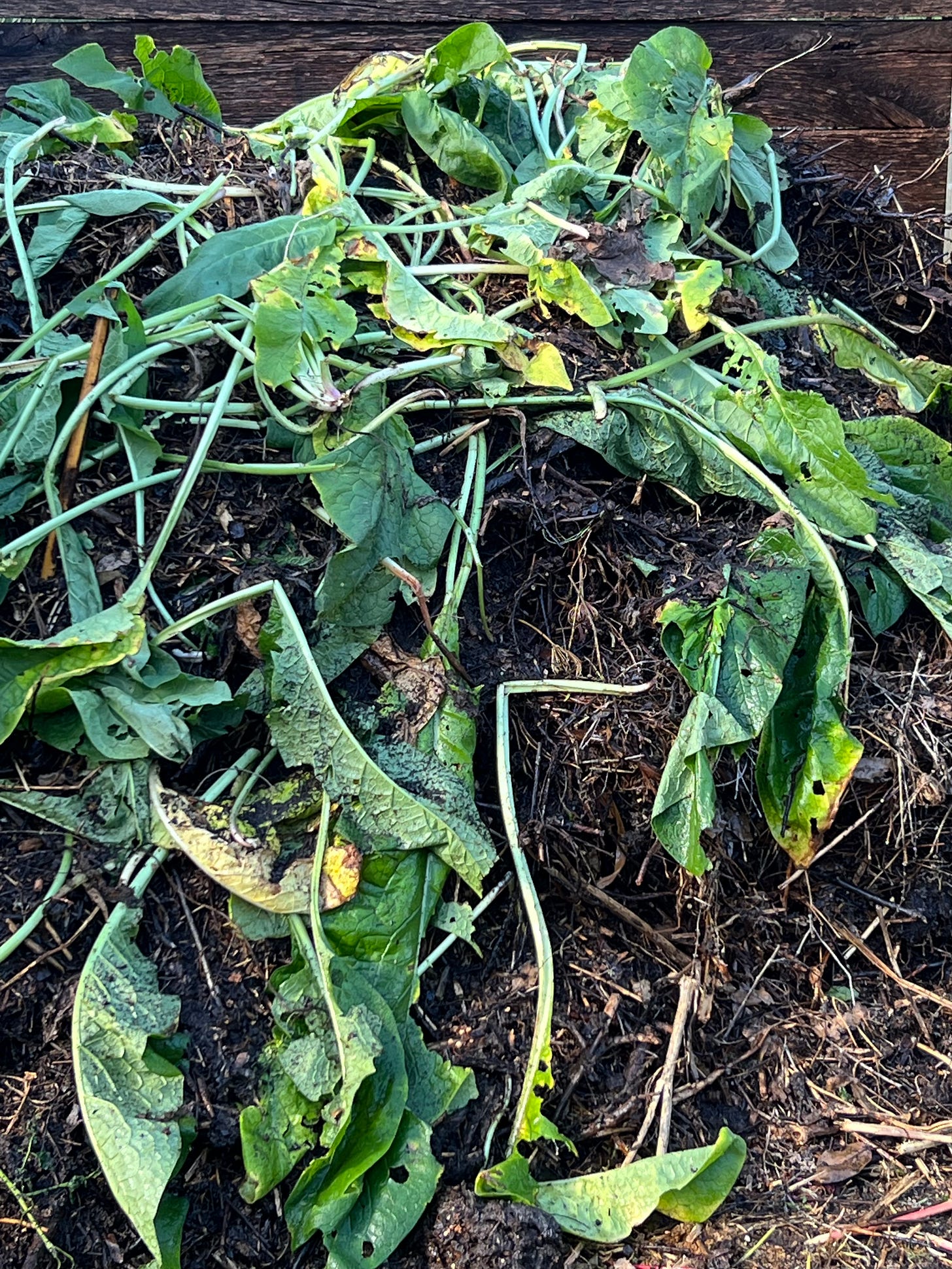


Sally I'm sorry it's taken so long to reply...what a week! Much of my garlic has popped up today...precisely one week on...woohoo! Funny how there's no winning that argument about the veg...and turnips and swedes can definitely be a bit of a no-go zone. Try that one with the aubergines though...you just might win him over. Mx
Well I did plant the garlic before you as I was not so sure I would want to be outside in the freezing cold, as it turned out it did rain so that was a benefit. Unlike you we don’t have the space in our garden so the majority were planted in pots the remainder in our raised garden bed, so it will be a race to see which start sprouting first. We all seem to be having an issue with beetroot, for me it is to find some in the Supermarket (canned) so I think I will be reverting to buying fresh and cooking my own. Thank you for your recipe, I love eggplant but unfortunately it is not my husbands favourite, so I am always looking for a way to surprise him. A bit like with Swede, he says he doesn’t like it either, but there was a time I cooked it and he ate without complaint, the next time he said, you know I don’t like Swede, me, well you ate it the other night, him, no that was Pumpkin, me, No! It was Swede lol… thank you for another great read. You certainly are one for expansion in words. I try but still don’t seem to go past 4-5 minutes.